Microsoft 365 Monitoring — Five Tips for Ensuring Excellent Communication and Collaboration
 To transform their businesses, enterprise IT leaders have focused on improving collaboration and teamwork. It’s a matter of survival. Customers demand more choices and better service. So companies need to speed up their response. Smaller, more agile “digital native” start-ups have built-in advantages in responding to changing customer demands. They can often out-maneuver larger companies with complex organizations or sophisticated global supply chains. Microsoft 365 helps enterprises address these challenges. Plenty of Microsoft 365 monitoring tools exist. But ensuring Microsoft 365 delivers excellent end user experience is fundamental to success.
To transform their businesses, enterprise IT leaders have focused on improving collaboration and teamwork. It’s a matter of survival. Customers demand more choices and better service. So companies need to speed up their response. Smaller, more agile “digital native” start-ups have built-in advantages in responding to changing customer demands. They can often out-maneuver larger companies with complex organizations or sophisticated global supply chains. Microsoft 365 helps enterprises address these challenges. Plenty of Microsoft 365 monitoring tools exist. But ensuring Microsoft 365 delivers excellent end user experience is fundamental to success.
Microsoft 365 overview
Microsoft 365 Enterprise combines Office 365, Windows 10 Enterprise, and Enterprise Mobility and Security. It fosters a connected workplace that delivers secure, anytime, anywhere access to business-critical applications and content, across different geographic locations and different workstyles. Microsoft 365 components include the following (many of which Riverbed itself uses).
- Companies, including Riverbed, use SharePoint as their company portal to share news, plans, and enablement material.
- Productivity apps and Office 365 Pro Plus enable teams to collaborate in real-time on documents.
- Partners, suppliers, and employees use Skype for Business and Microsoft Teams to communicate via voice, video, and chat across a globally distributed user base.
- Companies like Riverbed rely on Yammer for brainstorming, collaborating, and communicating. We use Yammer both generally across the company, and within specific groups focused on products, markets, or recreational interests.
- And of course, Exchange email and calendars provide the foundation to collaboration.
Microsoft 365 monitoring—the role of end user experience monitoring
It almost goes without saying that enterprises won’t achieve Microsoft 365’s teamwork and creativity benefits if the apps, content, and communication don’t deliver excellent end user experience. That’s where Microsoft 365 monitoring from SteelCentral Aternity comes in. Part of the SteelCentral Digital Experience Management platform, Aternity End User Experience Monitoring tracks application and device performance from the point of IT consumption – the end user’s device. It provides visibility to IT of exactly what users see by monitoring the “click to render time” of applications. For applications, IT can see exactly how long it took to send an email, open a presentation, or upload a file. All without tagging the code-especially important for 3rd party, SaaS-delivered apps. For Skype for Business voice calls, it monitors the Mean Opinion Score (MOS), measured from the end user’s device.
Watch this short video to see SteelCentral Aternity in action for Microsoft environments:
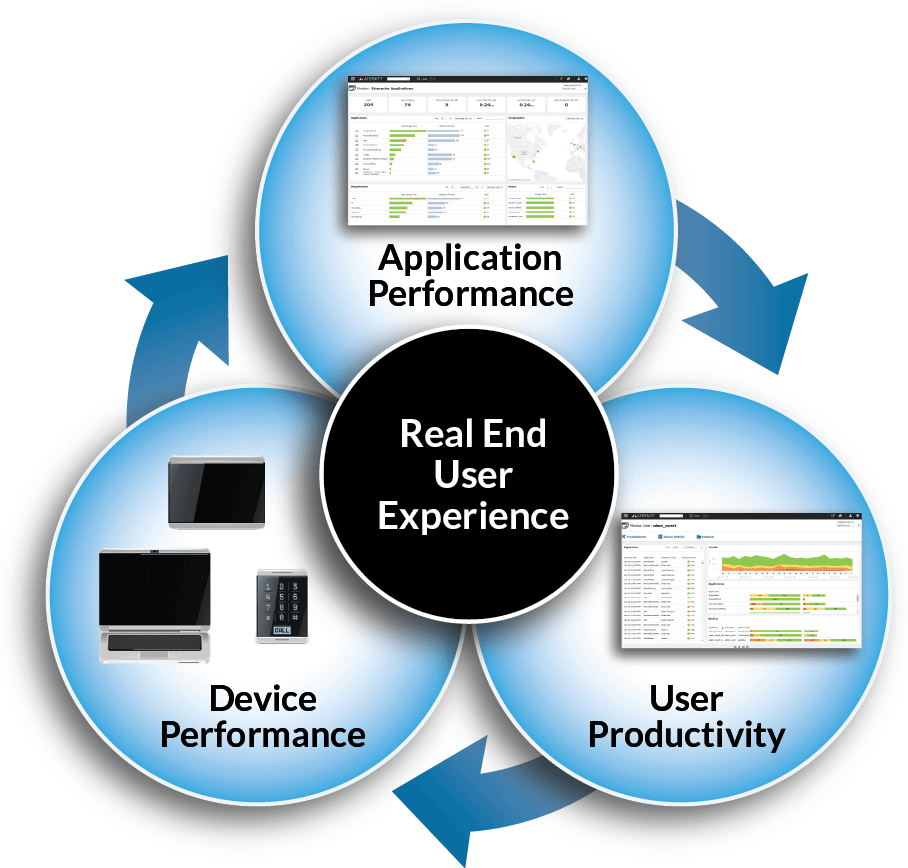
Aternity monitors the three streams of data that constitute end user experience
Unlike device performance monitoring products, SteelCentral Aternity monitors and correlates together the three streams of data that constitute true user experience—user productivity, device health and performance, and application performance as seen by the end user. Aternity monitors end user experience for EVERY type of app – web or Windows, running locally or in the cloud, or even delivered via SaaS. And it monitors end user experience for applications delivered on ANY device – laptop, PC, tablet, smart phone, or virtual desktop. This broad application and device performance is key for mobile workspace initiatives like Microsoft 365 that enable anytime, any place access to content from any device.
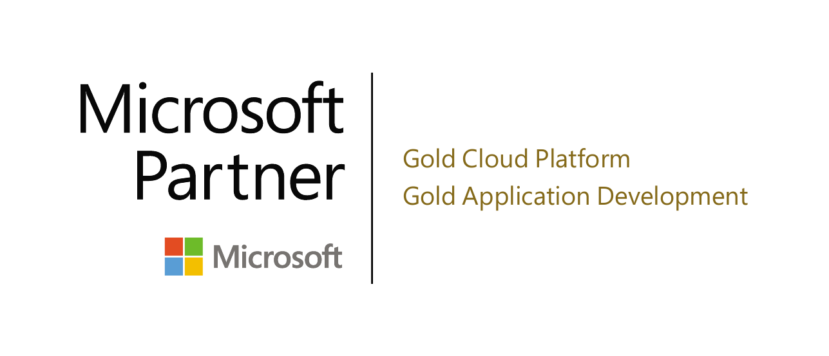 SteelCentral Aternity is certified as Windows 10 Ready, and is the foundation of Riverbed’s gold certification in Microsoft’s Application Development Competency.
SteelCentral Aternity is certified as Windows 10 Ready, and is the foundation of Riverbed’s gold certification in Microsoft’s Application Development Competency.
5 ways to use Aternity to ensure excellent user experience for Microsoft 365
With capabilities like these, Aternity enables IT to ensure excellent end user experience for Microsoft 365. Here are five examples.
1. Windows 10
For Windows 10 migrations, IT must verify that app and device performance is as good or better than it was on earlier OS versions. Aternity provides IT with a side by side comparison so they can execute migrations with confidence. Enterprises use Aternity as part of comprehensive, enterprise-wide change management initiatives, such as Lean, or the Deming Cycle, to provide visibility into the impact of IT change on end user experience. Learn more with our free Windows 10 Migration Guide.
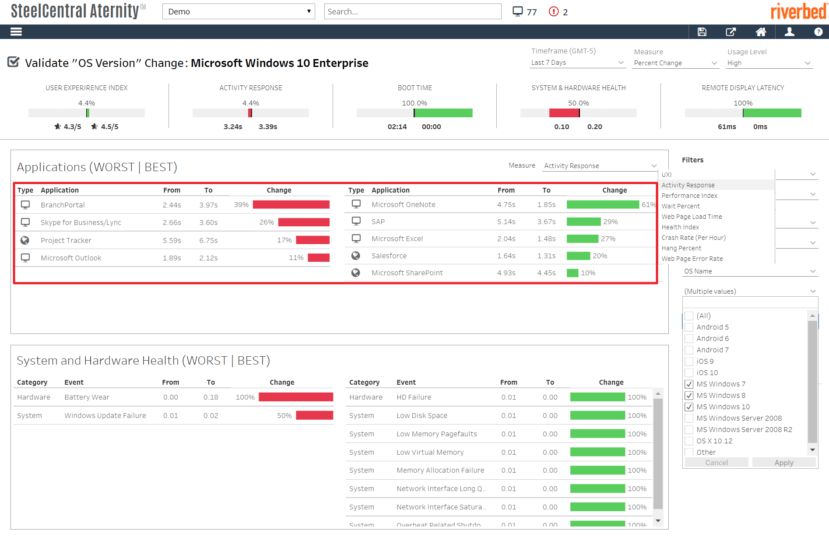
Aternity shows that Skype for Business and Outlook perform worse on Windows 10, so IT should investigate before proceeding with wider roll-out.
And Aternity provides this type of analysis for a myriad of device configuration changes. So IT can cost justify changes and can compare performance to ensure success.
2. Productivity Apps
SteelCentral Aternity monitors the response time that users see when they use applications in the context of a business workflow. For example, within Microsoft Outlook, Aternity monitors how much time it takes to preview an e-mail, schedule a new meeting, or open a calendar item. Aternity automatically calculates a baseline for normal performance of these activities, but that’s not all. The baselines can vary, by geography, or device type, or OS. This makes sense, since performance should differ for users on new machines vs under-resourced, outdated ones. And Aternity breaks down the overall response time of the activity into its component parts—that contributed by the client device, the network, and the server. Aternity automatically notifies IT of incidents when expected thresholds are exceeded.
Here’s a dashboard straight from the Riverbed environment.
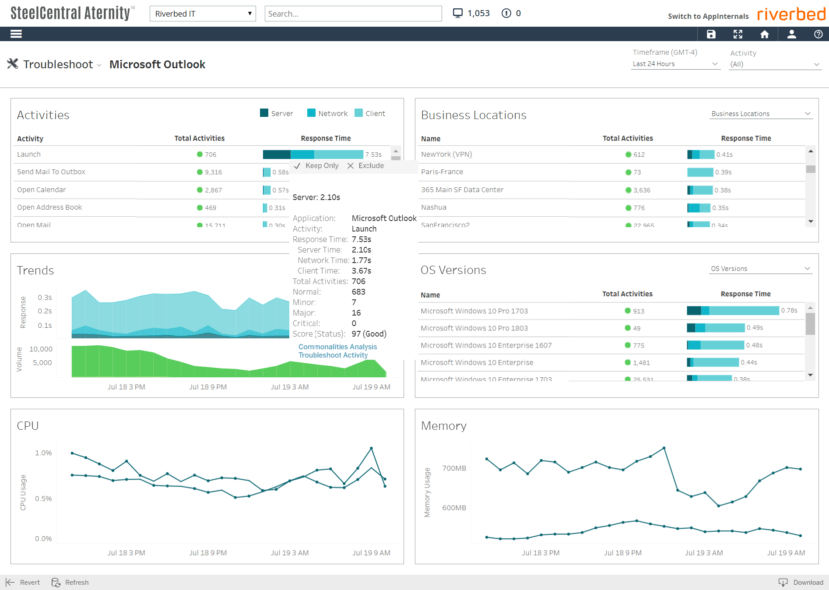
Aternity shows that launching Outlook takes 7.53 seconds, and that client time is the major contributor to delay. Windows 10 Pro 1703 takes almost double the time of other OSs.
Aternity provides the mostly commonly used business activities for Microsoft productivity apps like Exchange, Outlook, Word, Excel, and PowerPoint. Aternity’s Web Activity Creator simplifies the process of building activities for web apps, and you can take training to learn how to build activities for other types of apps.
3. Skype for Business
With Skype for Business on-line, your workforce can easily communicate across geographies through voice, video, and message. Skype for Business fosters key functions like collaborating on presentations, product reviews, and design iterations. In many cases, Skype for Business enables companies to save money by retiring third-party web conferencing and communication solutions. But IT can reap these benefits only if they deliver excellent end user experience. Aternity monitors voice quality from the perspective of the end user. It measures Mean Opinion Score, call volumes and trends, and the reasons for call failures across the entire organization.
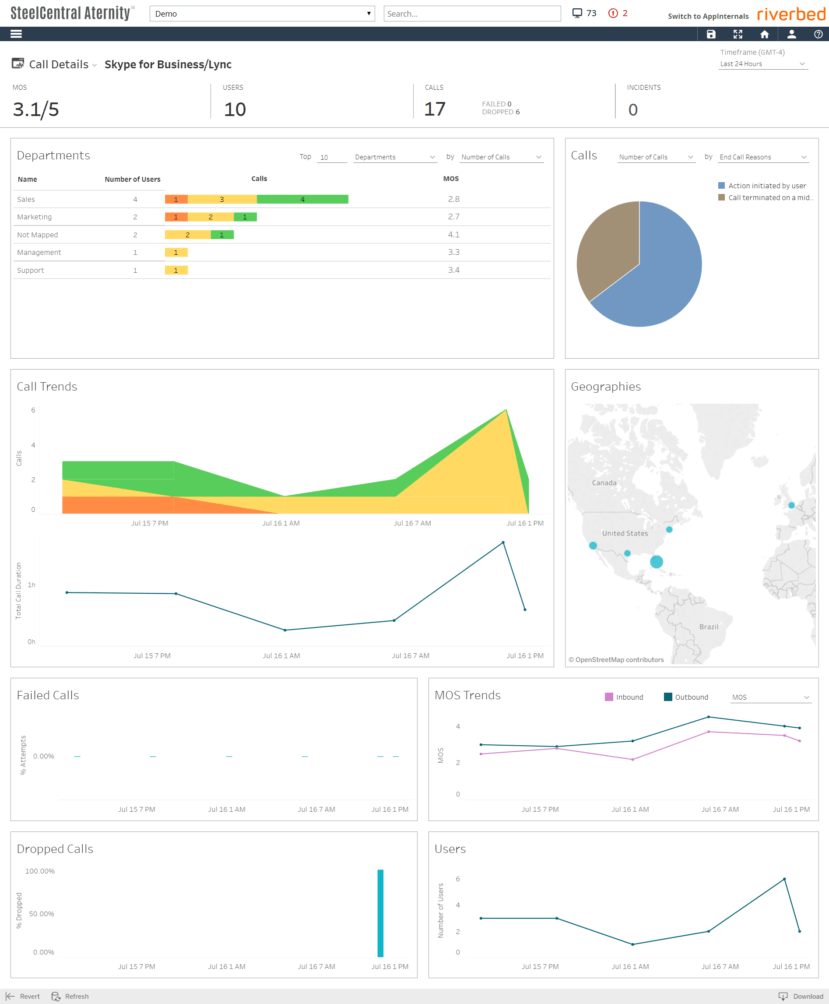
SteelCentral Aternity monitors key Skype for Business metrics like MOS, call volumes, call drops and failures, by location and department, so IT can track performance and ensure quality service.
4. SharePoint
Aternity provides the same type of proactive End User Experience Monitoring for SharePoint as it does for any of the other Microsoft productivity apps. With Aternity, IT can monitor, troubleshoot, and validate the impact of new versions of SharePoint on end user experience. As shown in the video above, IT can compare the performance of SharePoint before and after a change, to ensure that new versions provide excellent service.
5. Mobile
Mobile Device Management and Mobile App Management are just the start when it comes to empowering a mobile workforce. Managing and securing devices and apps are necessary, but not sufficient steps to ensure a productive mobile workforce. The next step is to use Aternity Mobile APM to ensure an excellent mobile user experience for enterprise mobile apps used by the workforce and consumers.

SteelCentral Aternity monitors crashes, errors, response time and other parameters for enterprise mobile apps used by your workforce and customers.
SteelCentral Aternity augments Microsoft 365 monitoring tools
Of course, a variety of tools exist for Microsoft 365 monitoring. SteelCentral Aternity provides unique capabilities that augment those from Microsoft.
Enterprises rely on Microsoft System Center Operations Manager (SCOM) for monitoring the availability and performance of physical and virtual devices within the data center. Aternity focuses on monitoring the actual end user experience of the workforce, as measured from the end user’s device.
Mobile administrators use Microsoft Intune for Mobile Device Management and Mobile App Management. As discussed above, Aternity monitors the performance of mobile apps, as seen by the end user.
With Device Health, desktop services teams get insight into the key performance and health metrics of their Windows device estate. Aternity also provides this insight, but in addition, correlates this data with the actual end user experience of applications, as they render on the screens of users’ devices.
Microsoft Office 365 Workplace Analytics gathers data from collaboration tools (calendar, email, IM, etc) to analyze user productivity/collaboration. It provides aggregated insight into how the workforce spends their time and who they spend it with. It helps IT and business leaders assess how much time employees spend in meetings, the number of redundant meetings, the number of people in meetings. For Aternity, it’s all about the workforce user experience. Aternity assesses the impact of poor IT performance on productivity by measuring application wait time, crashes, hangs, and errors.
Learn more about ensuring excellent collaboration and communication with Microsoft 365
 There are a variety of ways you can learn more about how Aternity adds value to Microsoft 365 monitoring. If you’re attending Microsoft Ignite in September, visit Riverbed in the Expo Hall. We’ll show you how Aternity augments Microsoft 365 monitoring for the use cases you care most about.
There are a variety of ways you can learn more about how Aternity adds value to Microsoft 365 monitoring. If you’re attending Microsoft Ignite in September, visit Riverbed in the Expo Hall. We’ll show you how Aternity augments Microsoft 365 monitoring for the use cases you care most about.
But you don’t have to wait to see Aternity in action. You can try Aternity running in our cloud environment by registering for Instant Access. You can also see Aternity in action for Office 365 by viewing this on-demand webinar on Speeding Office 365 Adoption.
